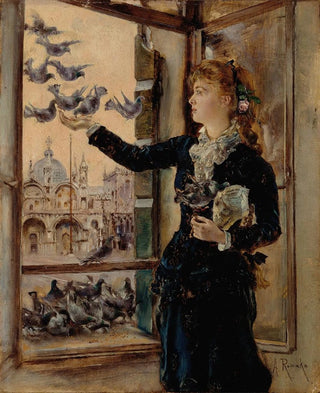Art print | Girl feeding pigeons at a window overlooking Piazza San Marco - Anton Romako


View from behind

Frame (optional)
In the vast panorama of 19th-century European art, Anton Romako's "Fille nourrissant des pigeons à une fenêtre donnant sur la place Saint-Marc" stands out for its delicacy and serene atmosphere. This piece, capturing a moment of tenderness and affection, transports the viewer to the heart of Venice, where light plays with shadows and pigeons, symbols of peace, blend into daily life. The scene, both intimate and universal, resonates with a melody of nostalgia, inviting everyone to pause and contemplate the beauty of everyday life. The art print of this work offers access to a rich artistic experience, where each brushstroke seems to whisper forgotten stories.
Style and uniqueness of the work
Romako's style is imbued with a unique sensitivity, characterized by meticulous attention to detail and a subtly chosen color palette. The Venetian light, with its golden reflections and pastel nuances, envelops the scene in an almost magical atmosphere. The young girl, with her gentle and focused gaze, embodies purity and innocence, while the pigeons, attracted by her presence, add a lively dimension to the piece. The composition, carefully balanced, directs the viewer's gaze toward the window, a symbol of openness to the outside world, while preserving the intimacy of the moment. Romako manages to capture a fleeting essence, transforming a banal act into a celebration of life, nature, and the bonds between humans and animals.
The artist and his influence
Anton Romako, born in 1832 in Austria, was a painter whose work is often marked by psychological depth and keen observation. Influenced by the great masters of the past, he developed a personal style that combines realism and impressionism. His ability to grasp human emotions and translate them onto the canvas makes him an essential figure of his time. The themes he explores, often related to daily life and urban landscapes, reveal a particular sensitivity.

Matte finish

View from behind

Frame (optional)
In the vast panorama of 19th-century European art, Anton Romako's "Fille nourrissant des pigeons à une fenêtre donnant sur la place Saint-Marc" stands out for its delicacy and serene atmosphere. This piece, capturing a moment of tenderness and affection, transports the viewer to the heart of Venice, where light plays with shadows and pigeons, symbols of peace, blend into daily life. The scene, both intimate and universal, resonates with a melody of nostalgia, inviting everyone to pause and contemplate the beauty of everyday life. The art print of this work offers access to a rich artistic experience, where each brushstroke seems to whisper forgotten stories.
Style and uniqueness of the work
Romako's style is imbued with a unique sensitivity, characterized by meticulous attention to detail and a subtly chosen color palette. The Venetian light, with its golden reflections and pastel nuances, envelops the scene in an almost magical atmosphere. The young girl, with her gentle and focused gaze, embodies purity and innocence, while the pigeons, attracted by her presence, add a lively dimension to the piece. The composition, carefully balanced, directs the viewer's gaze toward the window, a symbol of openness to the outside world, while preserving the intimacy of the moment. Romako manages to capture a fleeting essence, transforming a banal act into a celebration of life, nature, and the bonds between humans and animals.
The artist and his influence
Anton Romako, born in 1832 in Austria, was a painter whose work is often marked by psychological depth and keen observation. Influenced by the great masters of the past, he developed a personal style that combines realism and impressionism. His ability to grasp human emotions and translate them onto the canvas makes him an essential figure of his time. The themes he explores, often related to daily life and urban landscapes, reveal a particular sensitivity.






